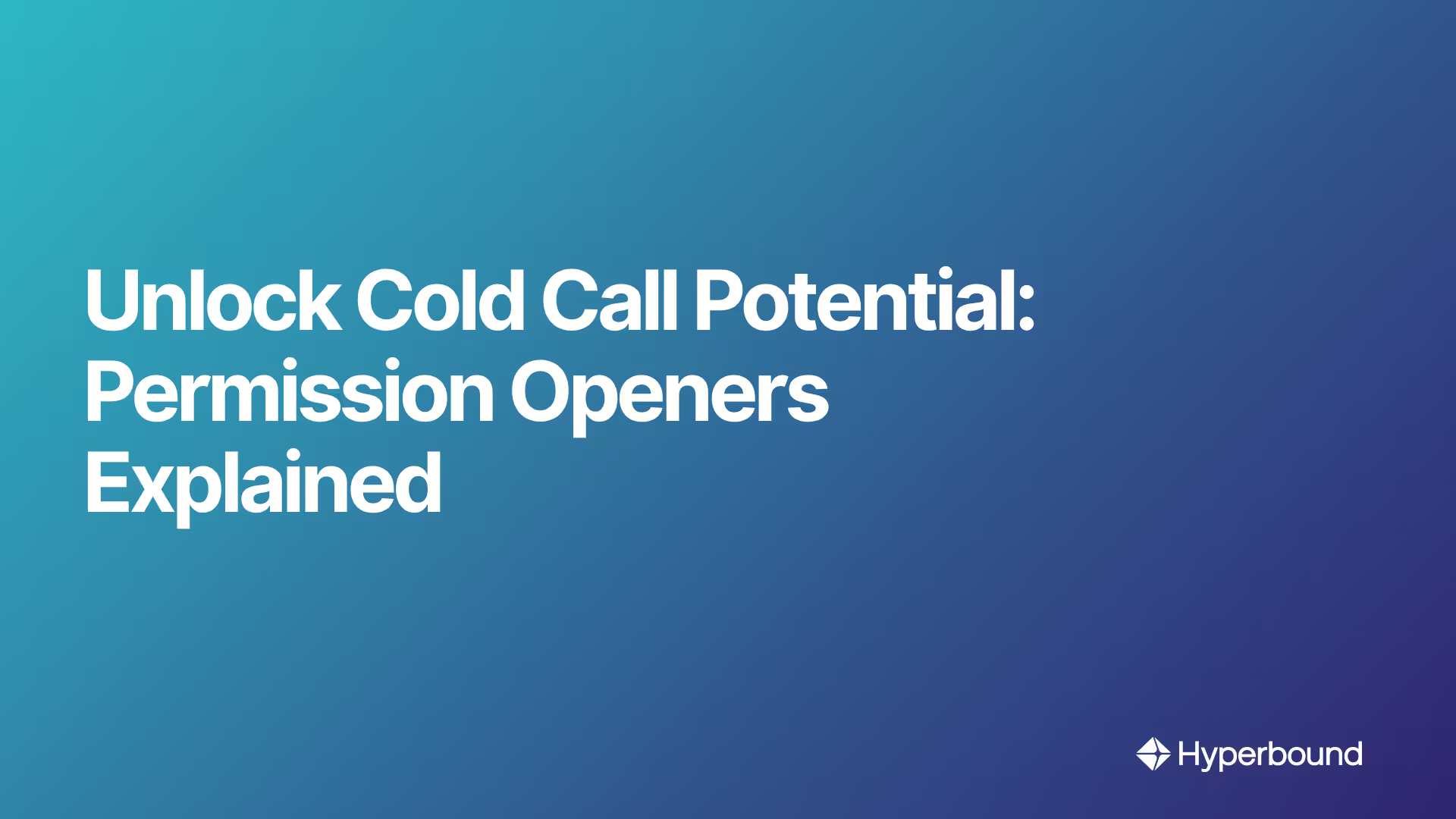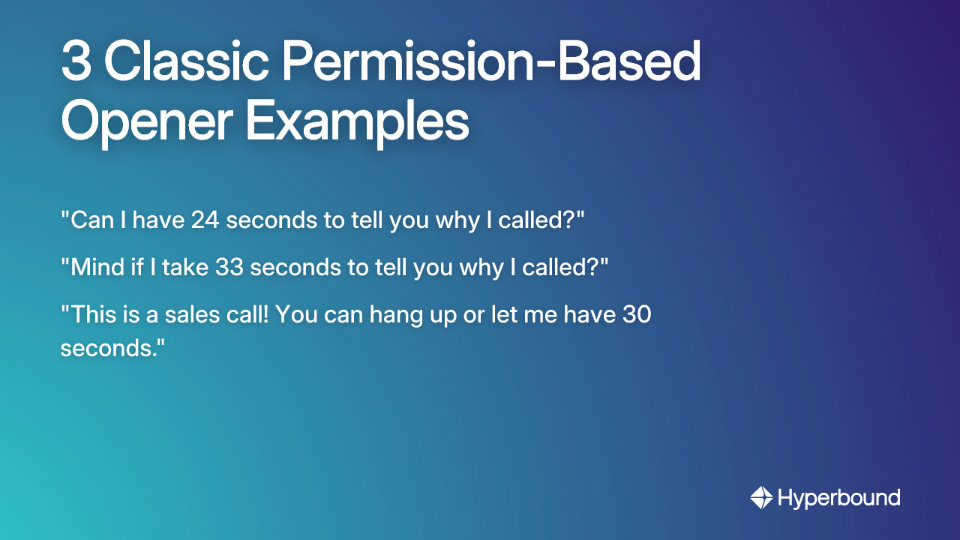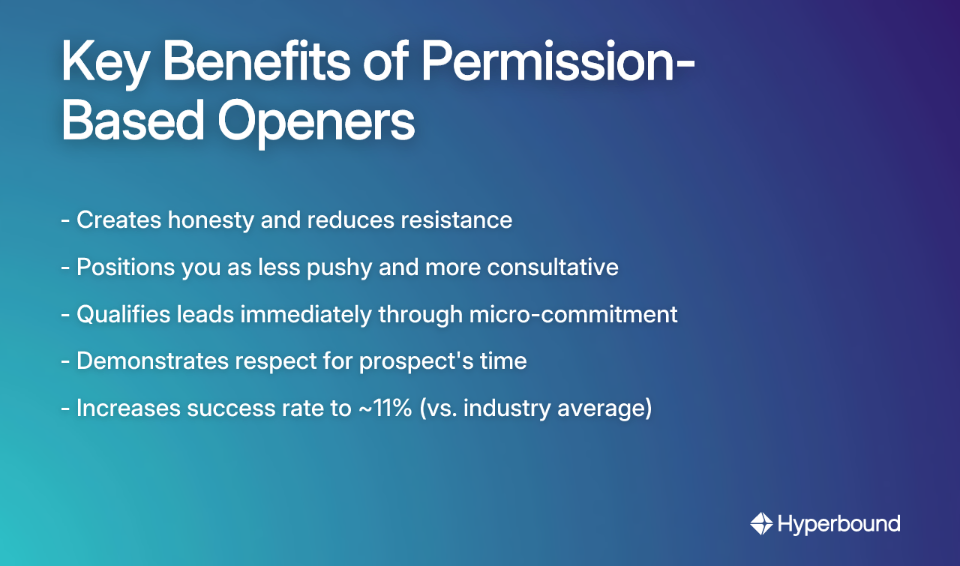
You've got about seven seconds before your prospect hangs up. Seven precious seconds to convince someone who wasn't expecting your call and doesn't know you to stay on the line. As a Business Development Representative (BDR), those first moments of a cold call can feel like walking a tightrope without a safety net.
"Hi, do you have a moment to talk about..."
Click.
Another rejection. Another prospect gone. Another dent in your confidence.
In the high-pressure world of cold calling, where the average sales team spends 15 hours per week making calls with only 2.5% leading to appointments, your opening line isn't just important—it's everything.
Enter the permission opener: that polite little question asking for the prospect's consent to continue the conversation. For years, it's been heralded as the magic bullet for cold calling success. But is it really the silver bullet that will save your cold call efforts, or just another way to get a quick "no"?
What Exactly is a Permission-Based Opener?
A permission-based opener (PBO) is a sales technique where you explicitly ask for the prospect's consent to proceed with the conversation. It acknowledges that your call is an interruption and gives the prospect control over whether to continue.
Some classic examples include:

- "Paul, this is Michael with ABC Co. I know I'm an interruption, can I have 24 seconds to tell you why I called?"
- "Corrine, this is Michael with ABC Co. Mind if I take 33 seconds to tell you why I called?"
- "Preston, this is Michael with ABC Co. This is a sales call! You can hang up or let me have 30 seconds to tell you why I'm calling."
The psychology behind this approach is simple: by acknowledging you're interrupting and giving the prospect control, you disarm their natural resistance. It's a pattern interrupt that aims to build rapport by demonstrating respect for the prospect's time.
The Case FOR Permission Openers: The "Savior" Argument
The data supporting permission openers is compelling. According to Gong.io's analysis of 300 million calls, a well-executed PBO has an 11.18% success rate, significantly outperforming other common openers. Similarly, an InsideSales study showed a 10% conversation rate for PBOs.
The benefits of permission openers include:

Creates Honesty and Reduces Resistance
By openly acknowledging that you're making a cold call, you disarm the prospect. This transparency aligns with the desire for authenticity that many salespeople and customers value. As one Reddit user put it, "Prospects know it's a sales call. Not acknowledging it feels dishonest."
Less Pushy, More Consultative
This approach makes you seem less intrusive and sets the stage for a consultative conversation. You're not barging in with your pitch; you're respectfully asking to share information that might be valuable.
Qualifies Leads Immediately
When a prospect agrees to give you time, they've made a small commitment to the conversation. This micro-commitment can lead to greater engagement throughout the call. Prospects who agree have given explicit permission, making them warmer leads from the outset.
The Case AGAINST Permission Openers: The "Waste of Time" Argument
Despite their popularity, permission openers have vocal critics who argue they sabotage more calls than they save.
Inviting Rejection
The most significant critique is that permission openers make it too easy for prospects to say "no." By asking "Do you mind if I take a minute of your time?" you've given them a perfect out. This speaks directly to the challenge many BDRs face when trying to convince hesitant prospects to engage.
Particularly problematic is the infamous "Did I catch you at a bad time?" opener, which, according to call analysis data, has a dismal 2.15% success rate. As one sales veteran on Reddit commented, "Every time is a bad time for an unexpected sales call."
Lack of Immediate Value
A well-crafted LinkedIn analysis argues that PBOs often start with a closed-ended question that fails to demonstrate any value. The prospect has no compelling reason to say "yes" because you haven't presented any benefit to continuing the conversation.
It's Become the "Meta"
What once worked as a pattern interrupt may no longer be effective. Many prospects have heard permission openers so often that they've developed automatic responses. As one Reddit commenter noted, "It seems like this is the current meta and no longer a pattern interrupt the way it used to be." When every BDR uses the same opener, none stand out.
Loss of Control
When you start by asking permission, you're already positioning yourself as subservient in the conversation. This can make it harder to guide the call toward your objectives or handle objections effectively. For many gatekeepers and decision-makers (DMs), this perceived weakness is a signal to end the call.
Beyond the Binary: How to Evolve Your Permission Opener
The truth about permission openers isn't black and white. Their effectiveness often comes down to execution and context. A generic "Do you have a minute?" lacks specificity and triggers skepticism, but a well-crafted permission opener can still be highly effective.
The solution? The Tailored Permission Opener.
Nick Cegelski from 30 Minutes to President's Club recommends a more sophisticated approach. The goal is to answer three questions for the prospect immediately:
- Who is this?
- Why are they calling?
- How long will this take?
The key difference is leading with specific context before asking for permission. For example:
"Hi [Name], this is [Your Name]. I just finished listening to a podcast you were on and it made me want to call you... Do you mind if I take one minute? I'll tell you why I called, and then you can tell me whether or not it's worth a chat."
This tailored approach provides immediate relevance and addresses the BDR's need for personalization in their script. The prospect hears something specific to them before being asked for permission, which dramatically increases engagement.

Handling Rejection
If your prospect says "no" to your permission request, don't hang up immediately. Students of Sales suggests following up with a disqualifying question: "Is that the case or is it that you don't take cold calls?"
This question can reveal whether it's a genuine timing issue or a blanket policy, giving you valuable information for future outreach while maintaining rapport during the brief window you have.
Powerful Alternatives When PBOs Don't Cut It
Not every market responds well to permission openers. In some industries like cybersecurity or when targeting C-suite executives, a different approach may be more effective. Here are two powerful alternatives that have proven successful:
Alternative 1: The Problem-Solution Approach
According to the LinkedIn counter-study, this approach has a 41% higher chance of securing a follow-up meeting compared to traditional permission openers.
How it works: Start by stating a specific, researched pain point relevant to the prospect's industry or role, then pivot to your solution.
Script Example:"Hi [Recipient's Name], I've noticed organizations like yours face challenges with [specific problem like vendor risk management]. I wanted to share how our platform helps. What's more pressing for you right now, [problem 1] or [problem 2]?"
This approach skips permission altogether and leads with value. It demonstrates you've done your homework and understand their industry challenges. By immediately focusing on pain points, you create relevance and urgency that can overcome the natural resistance to cold calls.
Alternative 2: The "Heard The Name Tossed Around" Opener
This approach was the highest-performing opener in the same study with an 11.24% success rate, slightly outperforming even the best permission openers.
How it works:
- Lead with a Common Connection: Mention a mutual contact, investor, competitor, or industry peer.
- Introduce Yourself Minimally.
- Casually Ask: "Have you heard our name tossed around?"
Script Example:"Hi [Name], this is [Your Name] from [Company]. I work with several companies in [industry/location] like [competitor names]. I was wondering if you'd heard our name tossed around at all?"
This creates social proof and a slight, productive discomfort if they haven't heard of you. If they say yes, ask what they've heard. If no, you have a perfect transition to your tailored pitch.
The Verdict: Your Call, Your Strategy
After analyzing the data and expert opinions, it's clear there's no single "best" cold call opener that works for every BDR in every situation. The choice between a permission opener, a direct problem-solution approach, or a social proof opener depends on your personality, your industry, and your prospect.
What matters most is authenticity. As one Reddit user advised, "The hardest part of cold calling is making the first call... but you should be doing no more than 30% of the talking." Whatever opener you choose, focus on creating a two-way conversation rather than delivering a monologue.
The Golden Rule: Test and Measure
The most valuable advice from Students of Sales is to select one opener, use it consistently for a week, and track your results in your CRM. Note your yes/no rates and meetings booked. Data, not opinion, should guide your strategy. AI-powered coaching platforms like Hyperbound can accelerate this process by automatically scoring calls against your playbook and providing analytics on which openers work best for your team.
Final Thoughts
Permission openers aren't inherently good or bad—they're tools. Like any tool, their effectiveness depends on how well they're used and whether they're appropriate for the job at hand.
The most successful BDRs aren't those who rigidly adhere to one approach, but those who understand the psychology behind different techniques and adapt them to their unique voice and market. They recognize when a prospect feels interrupted and annoyed, and they adjust accordingly.
Whether you choose to use permission openers or not, remember that your goal isn't to deliver a perfect script—it's to start a meaningful conversation that addresses your prospect's pain points and offers genuine value.
After all, the best cold call isn't the one with the cleverest opener—it's the one that ends with a meeting on the calendar.
Frequently Asked Questions
What is a permission-based opener in cold calling?
A permission-based opener (PBO) is a technique where a salesperson explicitly asks for a prospect's consent before launching into their pitch. This approach acknowledges the call is an interruption and gives the prospect control, often starting with lines like, "Can I have 24 seconds to tell you why I called?"
Why should I use a permission-based opener?
You should use a permission-based opener to build rapport and reduce resistance by showing respect for the prospect's time. Data shows that well-executed PBOs can significantly increase success rates (up to 11.18%) by creating honesty, positioning you as less pushy, and immediately qualifying leads who grant you permission to speak.
What are the main risks of using a permission opener?
The main risk is that it gives the prospect an easy way to say "no" and end the call immediately. Critics argue that PBOs like "Did I catch you at a bad time?" invite rejection, fail to provide immediate value, and have become so common they no longer work as a pattern interrupt.
How can I make my permission opener more effective?
You can make your permission opener more effective by tailoring it with specific context before asking for time. Instead of a generic question, lead with a piece of personalized information, such as mentioning a podcast they were on or a recent company event. This provides immediate relevance and makes the prospect more likely to grant you a moment to speak.
What are good alternatives to permission-based openers?
Good alternatives include the "Problem-Solution Approach" and the "Heard The Name Tossed Around" opener. The problem-solution approach leads with a researched pain point relevant to the prospect, while the other leverages social proof by mentioning mutual connections or competitors, both of which can be more effective in certain industries or with senior-level prospects.
How do I know which cold call opener is best for me?
The best way to know which opener works for you is to test and measure your results. Choose one opening strategy, use it consistently for a set period (like a week), and track key metrics like your yes/no rate and the number of meetings booked. The data you collect will show which approach is most effective for your specific audience and sales style.
What should I do if a prospect says "no" to my permission opener?
If a prospect says "no," don't hang up immediately. Instead, follow up with a disqualifying question like, "Is that because it's a bad time, or is it that you don't take cold calls?" This can help you understand whether it's a timing issue or a firm policy, providing valuable insight for future outreach attempts.
Book a demo with Hyperbound
.png)













